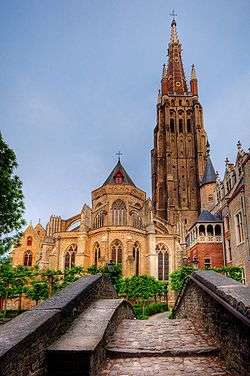Church of Our Lady, Bruges
The Church of Our Lady (Dutch: Onze-Lieve-Vrouwekerk) in Bruges, Belgium, dates mainly from the 13th, 14th and 15th centuries. This church is essentially "...a monument to the wealth, sophistication, taste, and devotion of this most Catholic city, whose history and faith stand today celebrated in this wonderful building." [1]
| Church of Our Lady | |
|---|---|
Dutch: Onze-Lieve-Vrouwkerk | |
 Church of Our Lady | |
| 51°12′17″N 3°13′28″E | |
| Location | Bruges |
| Country | Belgium |
| Denomination | Roman Catholic |
| Website | www |
| History | |
| Status | Parish church |
| Dedication | Mary |
| Architecture | |
| Functional status | Active |
| Architectural type | Church |
| Style | Gothic |
| Years built | 1270-1280 (choir) 14th/15th century (various additions) |
| Groundbreaking | 13th century |
| Specifications | |
| Height | 115.6 m (379 ft 3 in) |
| Materials | Brick |
| Administration | |
| Diocese | Bruges |
Its tower, at 115.6 metres (379 ft) in height, remains the tallest structure in the city and the second tallest brickwork tower in the world (after St. Martin's Church in Landshut, Germany).
The church demonstrates the Gothic style in the prominent Flying buttresses on the exterior which were constructed in the 1270s and 80s.[1] The nave contains cross-vaults and black and white tiled flooring.[1] The interior demonstrates the heavily ornamented Baroque style in the side aisles and chancel.[1] One of the chapels in the church was created in 1482 for a wealthy man named Lodewijk van Gruuthuse, as his personal worship area.[1]
Burials
In the choir space behind the high altar are the tombs of Charles the Bold, last Valois Duke of Burgundy, and his daughter, the duchess Mary. The gilded bronze effigies of both father and daughter repose at full length on polished slabs of black stone. Both are crowned, and Charles is represented in full armor and wearing the decoration of the Order of the Golden Fleece. The dress and ornamentation of the bronzed Mary is consistent with the Gothic style, and around the sides of the stone is a genealogy.[1] There is glass over the tomb opening so the frescoes on the walls are visible from above, with Jan Borman being the creator of the tomb.[1]
Madonna and Child
The altarpiece of the large chapel in the southern aisle, known as the Cappella sacra created in the 18th century in the Baroque style,[1] enshrines the most celebrated art treasure of the church—a white marble sculpture of the Madonna and Child created by Michelangelo around 1504. There is evidence of this date based on payments being made to Michelangelo by Florentine bankers Baldassare and Giovanni Balducci between 1503-1504.[2] The block of marble used to sculpt the Madonna weighed close to a ton so suitable locations for carving would have been limited. It is likely that Michelangelo began carving the sculpture in Carrara, as he was there for close to a year in 1505. The Madonna was completed in 1506.[2] It was probably meant originally for Siena Cathedral; however, it was purchased in Italy by two Brugean merchants, the brothers Jan and Alexander Mouscron. This was due to a monetary disagreement that led to Michelangelo having the statue brought privately to the Mouscrons in Bruges instead [3] and in 1514 it was donated to its present home. The sculpture was a memorial to the Mouscron parents, "...which would include a 'sumptuous tabernacle' that would hold an 'excellent' sculpture of the Virgin that is 'very precious' and 'costly'..." No alterations are allowed to be made to the Madonna without proper permission.[2] While Michelangelo was alive, the Madonna was the only sculpture to be taken out of Italy.[1] The sculpture was twice recovered after being looted by foreign occupiers—French revolutionaries c. 1794 and Nazi Germans in 1944. Close to the Michelangelo statue important Brugeans are buried such as Françoise de Haveskercke, buried next to her husband in the black tomb of the Haveskercke family on the right side of the statue.
Gallery
Exterior
Interior
 Nave
Nave
Works of art
 Madonna by Michelangelo
Madonna by Michelangelo Madonna by Michelangelo
Madonna by Michelangelo- Crucifixion by Anthony van Dyck (?)
 Supper at Emmaüs, formerly ascribed to Caravaggio
Supper at Emmaüs, formerly ascribed to Caravaggio- Deposition of the Cross; anonymous
References
- Flatley, Robert. "Kanopy". doi:10.5260/cca.199204. Cite journal requires
|journal=(help) - Sheedy, Lindsay. Marble made flesh : Michelangelo's Bruges Madonna in the service of devotion. OCLC 953876994.
- Stone, Richard E.; Mancusi-Ungaro, Harold R. (1973). "Review of Michelangelo: The Bruges Madonna and the Piccolomini Altar., Harold R. Mancusi-Ungaro, Jr". Renaissance Quarterly. 26 (3): 340–341. doi:10.2307/2859779. ISSN 0034-4338. JSTOR 2859779.
| Wikimedia Commons has media related to Onze-Lieve-Vrouwekerk (Brugge). |
- Bumpus, T. Francis (1909), The Cathedrals and Churches of Belgium [The Cathedral Series; 16], London: T[homas] W[erner] Laurie, pp. 138–144, OCLC 221948162.
- Hobbs, Jerry R. (9 January 2004), A Michelangelo in Belgium? The Bruges Madonna, Information Sciences Institute, USC Viterbi School of Engineering, University of Southern California, archived from the original on 8 June 2014.
- [Onze-Lieve-Vrouwekerk] (in Dutch), Kerknet Vlaanderen, archived from the original on 14 April 2012, retrieved 14 April 2012.
See also
- List of Gothic Cathedrals in Europe

